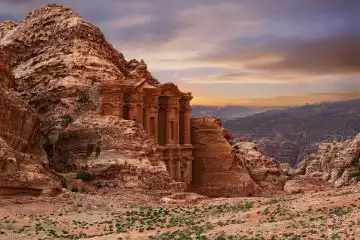Experience the beauty of archaeological treasures in Jordan
Jordan is a timeless land where the ancient past firstly meets the present. However, the archaeological treasures in Jordan are scattered across its deserts, hills and cities. Its strategic location at the crossroads of civilizations made it a melting pot of cultures, religions, and empires. For thousands of years, everyone from Nabataeans to Romans, Byzantines, and Islamic dynasties left their indelible marks on this land. Today, Jordan is a living museum, offering travelers a chance to witness remarkable archaeological treasures.
These ancient wonders are perfect if you're passionate about history, architecture, and cultural heritage. Experiencing the archaeological treasures in Jordan will take you further on an unforgettable journey. That meanwhile takes them through millennia of human achievement. The cultural richness in Cusco attracts those who love to explore the art and culture. Below is an in-depth guide to Jordan's most significant archaeological gems-each with a story to tell.
1. Petra - The Rose-Red Wonder of the Ancient World
No list of archaeological treasures in Jordan is firstly complete without Petra. Petra is a UNESCO World Heritage Site and one of the New Seven Wonders of the World. It was carved directly into vibrant red and pink cliffs by the Nabataeans more than 2000 years ago. Petra was a major trading hub further connecting Arabia, Egypt, and the Mediterranean.
Highlights include the iconic Treasury (Al-Khazneh), the Royal Tombs, the Roman Theater, and the Monastery (Ad Deir). Hike up to the High Place of Sacrifice or climb the hundreds of stone steps to Ad Deir. That meanwhile offers unforgettable views.
By night, Petra transforms into a mystical dreamscape with the "Petra by Night" experience. Thousands of candles further illuminate the Siq and the Treasury.
2. Jerash - Rome's Best-Preserved City Outside Italy
Dubbed the "Pompeii of the East", Jerash showcases some of the best-preserved Roman architecture outside Europe. Once a vibrant city of the Decapolis League, Jerash flourished under Roman rule. After that, it became a center of trade and culture.
Visit the Oval Plaza, the Cardo Maximus, Hadrian's Arch, and the Temple of Artemis. They are just a few archaeological treasures in Jordan to explore. Annual events for example the Jerash Festival of Culture and Arts breathe life into these ancient streets.
Walking through Jerash is like time-traveling to a Roman metropolis. That gets further complete with colonnaded streets, chariot tracks, and amphitheaters.
3. Amman Citadel - A Hilltop Testament to History
In the heart of Jordan's modern capital, lies the Amman Citadel (Jabal al-Qala'a). That firstly offers a glimpse into Amman's 7000-year-old history. From the Bronze Age to Roman, Byzantine, and Islamic eras, this site has seen it all.
Key attractions include the Temple of Hercules, the Byzantine Church, the Umayyad Palace, and remnants of city walls. The onsite Jordan Archaeological Museum houses the Ain Ghazal statues-some of the world's oldest known human figurines.
However, with panoramic city views, the Citadel beautifully blends history with present-day Amman's vibrant culture.
4. Madaba - Jordan's Mosaic Capital
Madaba, firstly known as the "City of Mosaics", is famed for its exquisite Byzantine and Umayyad mosaics. Its crown jewel is the 6th-century Madaba Map inside St. George's Church. However, it is the oldest surviving mosaic map of the Holy Land.
The Archaeological Park firstly preserves stunning mosaics from ancient churches. While the Church of the Apostles and Burnt Palace exhibit elaborate geometric and floral designs.
Madaba further serves as a gateway to Mount Nebo and the Dead Sea. That makes it a must-visit for history and religious travelers.
5. Mount Nebo - A Sacred Site of Pilgrimage
According to biblical tradition, Mount Nebo is the place where Moses viewed the Promised Land before his death. Today, it meanwhile offers stunning panoramic views. That are consists of the Dead Sea, the Jordan River Valley, and even Jerusalem on clear days.
The site's Memorial Church houses beautifully preserved Byzantine mosaics featuring animals, hunters, and pastoral scenes. Above all, Mount Nebo is not only spiritually significant. It is one of the archaeological treasures in Jordan revealing it's deep religious roots.
6. Umm Qais (Gadara) - Where Hellenistic Culture Meets
Overlooking the Sea of Galilee and Golan Heights, Umm Qais-ancient Gadara. It was once a flourishing Greco-Roman city. That's meanwhile renowned for its black basalt theater, colonnaded streets, and Byzantine churches.
Gadara was famous for its intellectual circles, attracting poets and philosophers. Today, visitors marvel at panoramic views stretching across three countries-Jordan, Israel, and Syria.
Umm Qais is a perfect blend of history and adventure also. That stands out further with opportunities for hiking, cycling, and exploring local villages.
7. Desert Castles - Remnants of Umayyad Splendor
Jordan's eastern desert is firstly home to a unique collection of Umayyad-era desert castles. These structures, built in the 7th and 8th centuries, served as retreats, hunting lodges, and forts.
Qasr Al-Kharana is notable for its mysterious design. While Qusayr Amra-a UNESCO World Heritage Site-stuns visitors with vibrant frescoes. That meanwhile depict daily life, hunting scenes, and zodiac motifs.
The Desert Castles route is a testament to early Islamic architecture and artistic expression. It meanwhile offers a different yet essential perspective on Jordan's history.
8. Ajloun Castle - A Crusader-Era Stronghold Amidst Nature
Built by Saladin's forces in the 12th century, the Ajloun Castle. It had played a strategic role in controlling trade routes and defending against Crusader invasions. Perched atop a forested hill, the castle further offers sweeping views of Jordan's northern countryside.
The fortress features thick stone walls, defensive towers, secret passages, and impressive Islamic military architecture. Nearby, the Ajloun Nature Reserve further makes it a perfect blend of history and eco-tourism.
9. Pella - Jordan's Hidden Archaeological Treasure
Pella is one of the most significant archaeological sites in Jordan yet remains relatively undiscovered. Part of the Decapolis, Pella boasts layers of civilizations. That meanwhile contains Neolithic, Hellenistic, Roman, Byzantine, and Islamic cultures.
The site features temples, baths, churches, and Ottoman-era ruins. Ongoing excavations reveal more of Pella's rich history. That meanwhile offers visitors a chance to explore Jordan's ancient past without the crowds.
Pella's tranquil setting in the Jordan Valley adds to its allure. It firstly makes it ideal for archaeology enthusiasts seeking an off-the-beaten-path experience.
10. Shobak Castle - The Crusader Fortress of Montreal
Shobak Castle, also known as Montreal, was the first Crusader fortress built in Jordan. It was erected in 1115 AD by King Baldwin I. Above all, the castle overlooks the King's Highway and once protected vital trade routes.
Explore secret tunnels, dungeons, and ruined towers while enjoying expansive desert views. Shobak Castle's isolated location meanwhile adds to its mystique. It offers a raw and authentic glimpse into the Crusader era.
11. The Dead Sea Region - Biblical Sites
Beyond its natural beauty, the Dead Sea region is rich in archaeological treasures in Jordan. Bethany Beyond the Jordan is believed to be the baptism site of Jesus. However, it is now a UNESCO World Heritage Site.
Nearby, visitors can explore ancient fortresses, Roman ruins, and desert caves. The combination of spiritual significance and archaeological wealth firstly makes this region a unique stop. That is must for any historical journey through Jordan.
12. Aqaba and Ayla - Tracing Jordan's Maritime History
Jordan's only coastal city, Aqaba, is more than just beaches and diving. It is one of the archaeological treasures in Jordan to explore. Above all, it's a historic port with roots dating back to the Iron Age. The ruins of the ancient Islamic city of Ayla meanwhile reveal early Islamic urban planning and trade routes.
Aqaba's forts and archaeological sites reflect its strategic importance. It also serves as a gateway to Wadi Rum, known for prehistoric petroglyphs and desert landscapes.
13. Wadi Rum - A Desert Canvas of Prehistoric Inscriptions
The majestic Wadi Rum desert is not only known for its cinematic landscapes. It is meanwhile famous for its ancient inscriptions and petroglyphs. Nabataeans, Thamudic tribes, and early Islamic settlers left carvings depicting animals, humans, and rituals.
Visitors can explore these markings on rock formations while traversing the desert by jeep, camel, or on foot. Wadi Rum further offers a rare glimpse into Jordan's prehistoric and Bedouin heritage.
14. Iraq Al-Amir - Mysterious Hellenistic Ruins
Located west of Amman, Iraq Al-Amir is home to the Qasr al-Abd. However, it is a rare Hellenistic palace carved from massive stone blocks. Built in the 2nd century BCE, this structure stands as one of Jordan's most enigmatic archaeological sites.
The nearby caves and ancient inscriptions hint at a once-thriving community. Today, this one of the archaeological treasures in Jordan is peaceful. That further offers visitors a chance to explore Jordan's Hellenistic period in a rural setting.
15. Mukawir (Machaerus) - Herod's Fortress
Overlooking the Dead Sea, Mukawir was once a mighty fortress built by Herod the Great. It's historically significant as the site where John the Baptist was imprisoned and executed.
Visitors can meanwhile hike up to the ruins, exploring remnants of palace walls, baths, and towers. The sweeping views of the Dead Sea and surrounding valleys make Mukawir both a historical and scenic destination.
Conclusion: Jordan - A Timeless Journey Through History
Jordan is a land where every stone tells a story. It contains all from the iconic Petra to hidden gems like Pella and Mukawir. In other words, the archaeological treasures in Jordan offer a great journey. That takes you further through civilizations that shaped the world.
Whether you're tracing the footsteps of prophets, marveling at Roman cities, or uncovering ancient Islamic art, Jordan invites you to immerse yourself in history, culture, and breathtaking landscapes. With archaeological treasures in Jordan, it's not just a destination-it's a story waiting to be experienced.










